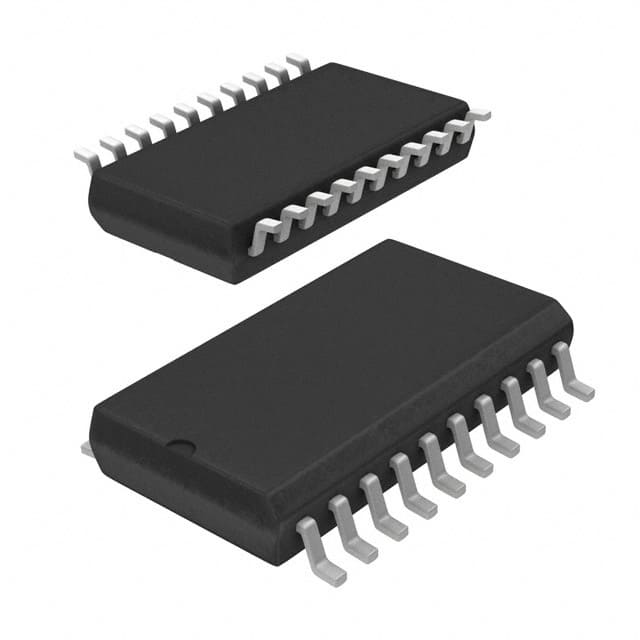Lihat spesifikasi untuk detail produk.

SN74LVC541ADWG4
Product Overview
- Category: Integrated Circuit (IC)
- Use: Buffer/Driver
- Characteristics: Low-voltage, CMOS technology
- Package: SOIC (Small Outline Integrated Circuit)
- Essence: Non-inverting octal buffer/driver with 3-state outputs
- Packaging/Quantity: Tape and reel, 2500 units per reel
Specifications
- Supply Voltage Range: 1.65V to 5.5V
- Input Voltage Range: 0V to VCC
- Output Voltage Range: 0V to VCC
- High-level Input Voltage: 0.7 x VCC to VCC
- Low-level Input Voltage: 0V to 0.3 x VCC
- High-level Output Voltage: 0.9 x VCC to VCC
- Low-level Output Voltage: 0V to 0.1 x VCC
- Maximum Operating Frequency: 80 MHz
- Number of Inputs/Outputs: 8
Detailed Pin Configuration
The SN74LVC541ADWG4 has a total of 20 pins. The pin configuration is as follows:
- OE (Output Enable) - Active low output enable input
- A1 - Data input/output 1
- Y1 - Data output 1
- A2 - Data input/output 2
- Y2 - Data output 2
- GND - Ground
- A3 - Data input/output 3
- Y3 - Data output 3
- A4 - Data input/output 4
- Y4 - Data output 4
- VCC - Positive power supply
- A5 - Data input/output 5
- Y5 - Data output 5
- A6 - Data input/output 6
- Y6 - Data output 6
- A7 - Data input/output 7
- Y7 - Data output 7
- A8 - Data input/output 8
- Y8 - Data output 8
- GND - Ground
Functional Features
The SN74LVC541ADWG4 is a non-inverting octal buffer/driver with 3-state outputs. It is designed to be used as a voltage level translator and line driver for various applications. The device operates at low-voltage levels and utilizes CMOS technology, making it suitable for battery-powered devices and other low-power applications.
The 3-state outputs allow the device to be connected to a bus or other multiple devices without causing contention. When the output enable (OE) pin is high, the outputs are in a high-impedance state, effectively disconnecting them from the bus.
Advantages and Disadvantages
Advantages of the SN74LVC541ADWG4 include:
- Low-voltage operation allows for compatibility with a wide range of systems.
- CMOS technology provides low power consumption and high noise immunity.
- 3-state outputs enable easy connection to buses and multiple devices.
Disadvantages of the SN74LVC541ADWG4 include:
- Limited maximum operating frequency compared to some other buffer/driver ICs.
- Availability may vary depending on the supplier and region.
Working Principles
The SN74LVC541ADWG4 operates by receiving data inputs (A1-A8) and driving corresponding outputs (Y1-Y8). The direction of data flow depends on the logic levels applied to the inputs and the state of the output enable (OE) pin.
When OE is low, the outputs follow the inputs, providing a non-inverted signal. When OE is high, the outputs are in a high-impedance state, effectively disconnecting them from the bus.
The device operates within a specified voltage range and provides level shifting capabilities, allowing it to interface between systems with different voltage levels.
Detailed Application Field Plans
The SN74LVC541ADWG4 is commonly used in various applications, including:
- Microcontroller interfacing: The IC can be used to interface microcontrollers with other devices, such as sensors, displays, and memory modules.
- Bus drivers: It can be employed as a buffer/driver for bidirectional data buses, ensuring proper signal transmission between multiple devices.
- Level translators: The IC facilitates voltage level translation between different logic families or systems operating at different voltage levels.
- Signal amplification: It can be utilized to amplify weak signals before further processing or transmission.
Detailed and Complete Alternative Models
Some alternative models that offer similar functionality to the SN74LVC541ADWG4 include:
- 74HC541: This IC is compatible with TTL logic levels and offers similar features to the SN74LVC541ADWG4.
- CD4050: It is
Sebutkan 10 pertanyaan dan jawaban umum terkait penerapan SN74LVC541ADWG4 dalam solusi teknis
Sure! Here are 10 common questions and answers related to the application of SN74LVC541ADWG4:
Q: What is SN74LVC541ADWG4? A: SN74LVC541ADWG4 is a type of octal buffer/line driver with 3-state outputs, commonly used in digital systems.
Q: What is the voltage supply range for SN74LVC541ADWG4? A: The voltage supply range for SN74LVC541ADWG4 is typically between 1.65V and 5.5V.
Q: What is the maximum output current that SN74LVC541ADWG4 can handle? A: SN74LVC541ADWG4 can handle a maximum output current of 32mA per channel.
Q: Can SN74LVC541ADWG4 be used for level shifting applications? A: Yes, SN74LVC541ADWG4 can be used for level shifting as it supports both 3.3V and 5V logic levels.
Q: How many input/output channels does SN74LVC541ADWG4 have? A: SN74LVC541ADWG4 has 8 input/output channels.
Q: What is the purpose of the 3-state outputs in SN74LVC541ADWG4? A: The 3-state outputs allow multiple devices to share a common bus without interfering with each other.
Q: Can SN74LVC541ADWG4 be used for bidirectional communication? A: No, SN74LVC541ADWG4 is unidirectional and can only be used for one-way data transmission.
Q: What is the typical propagation delay of SN74LVC541ADWG4? A: The typical propagation delay of SN74LVC541ADWG4 is around 3.5ns.
Q: Can SN74LVC541ADWG4 handle high-speed data transmission? A: Yes, SN74LVC541ADWG4 is designed for high-speed operation and can handle data rates up to 80Mbps.
Q: What is the package type for SN74LVC541ADWG4? A: SN74LVC541ADWG4 comes in a TSSOP-20 package.
Please note that these answers are general and may vary depending on the specific datasheet and application requirements.

